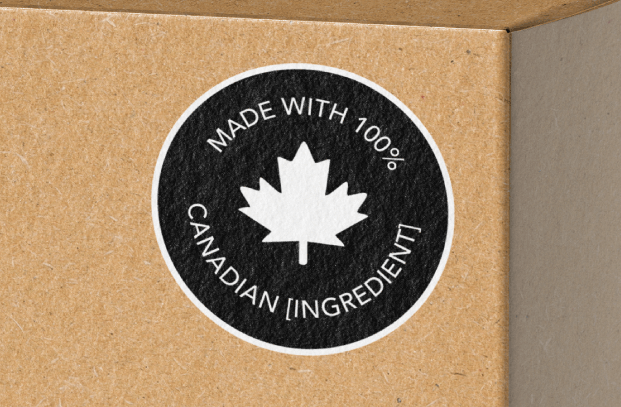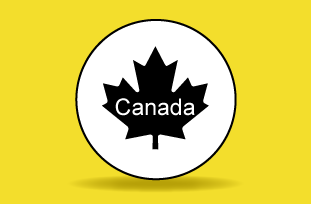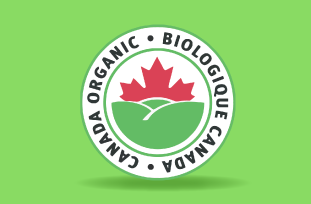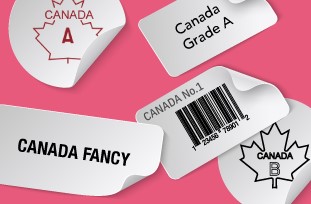Find out how to spot different words or symbols you might find on a label – some mean it has Canadian content, while others mean it meets a Canadian standard for food quality or organic content.
On this page
- Product of Canada
- Made in Canada
- 100% Canadian
- Other Canadian content claims
- Use of the maple leaf
- Inspection legend
- Canada Organic logo
- Canadian grades
- Country of origin for imported products and ingredients
- Video: Choose Canada – Labelling guide
- How to report misleading food labels
- More information
Product of Canada
Product of Canada means the processing and labour are Canadian and a significant amount of the ingredients are Canadian.
Look for the words "Product of Canada" on food products. There is no official logo. The maple leaf can be included but is not required.
Find out more about "Product of Canada" and "Made in Canada" claims.
Made in Canada

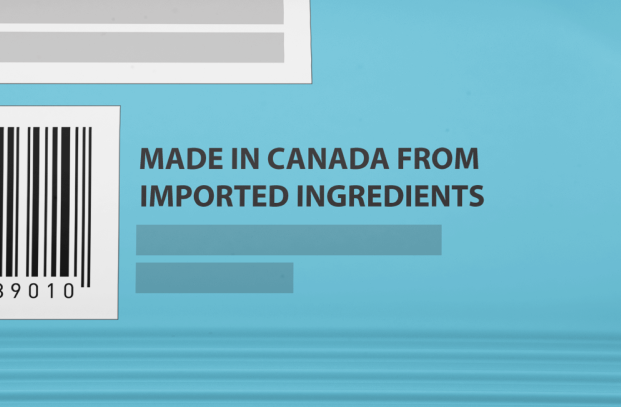
Made in Canada means the last substantial transformation of the product occurred in Canada. For example, the processing of cheese, dough, sauce and other ingredients to create a pizza would be considered a substantial transformation.
Whenever the "Made in Canada" claim is used, it must also include a qualifying statement to indicate whether the food product is made in Canada from imported ingredients or a combination of imported and Canadian ingredients.
There is no official logo for "Made in Canada" on food products, so look for qualifying statements like:
- Made in Canada from domestic and imported ingredients
- Made in Canada from 100% Canadian (ingredient name) and imported ingredients
- Made in Canada from imported ingredients
The maple leaf can be included but is not required.
Find out more about "Product of Canada" and "Made in Canada" claims.
100% Canadian
When the claim "100% Canadian" is used on a label, this means all of the ingredients, processing and labour used to make the food is Canadian.
It can also be used to highlight where an ingredient came from as part of a "Made in Canada" claim, or other claims. For example, "Contains 100% Canadian wheat" means all of the wheat and all the products derived from wheat (like wheat bran) used in that food are Canadian.
The maple leaf can be included but is not required.
Find out more about "100% Canadian" claims on foods or ingredients.
Other Canadian content claims
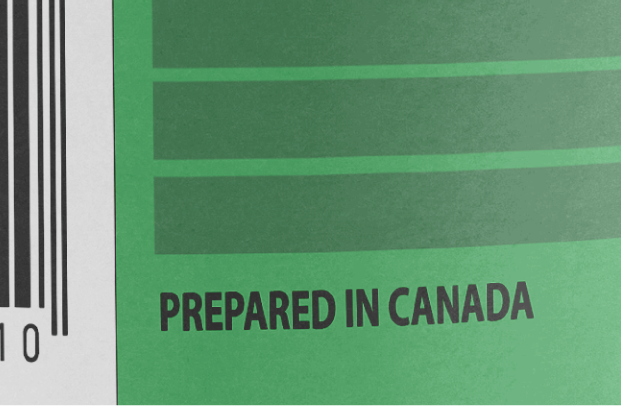
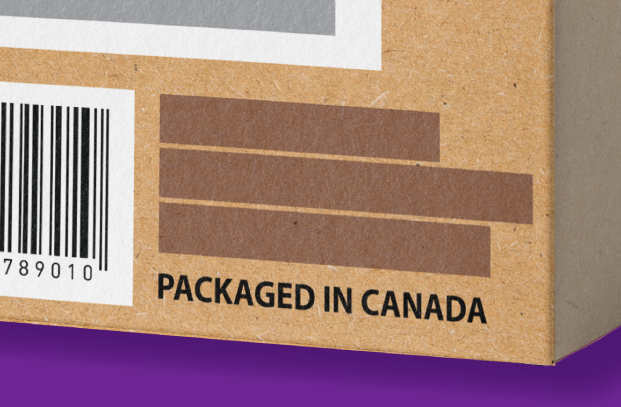
Other statements or claims that describe the Canadian value added may be used on food labels. The ingredients may have been imported, unless the label says they are Canadian. The maple leaf can be included but is not required.
Look for descriptive words about a product's Canadian value, like:
- "Roasted and blended in Canada" to describe coffee since the coffee beans are always imported
- "Distilled in Canada" to describe bottled water that was distilled in Canada
- "Canned in Canada" to describe a food that was canned in Canada
- "Processed in Canada" to describe a food which has been entirely processed in Canada
- "Prepared in Canada" to describe a food which has been entirely prepared in Canada
- "Packaged in Canada" to describe a food which is imported in bulk and packaged in Canada
You might also find "Prepared for" when used to describe a food that was prepared for a retailer in Canada. This doesn't mean the food was prepared in Canada.
Find out more about other Canadian content claims.
Use of the maple leaf
A maple leaf on food labels, advertisements, logos, store shelves or online can indicate a number of different things, such as:
- Canadian input, including ingredients, processing and/or labour
- the product is made by a Canadian company
- the product meets a Canadian standard, including for quality or organic content
There is no official logo for Canadian food products and a maple leaf on a product does not always mean the product is Canadian. Use this guide when reading food labels to help you decide if the product meets your needs.
Inspection legend
This is used for meat products, fish, and processed egg products and means it was made in accordance with the Safe Food for Canadians Regulations in a facility located in Canada that is licensed by the Canadian Food Inspection Agency (CFIA). It does not, by itself, mean that a food contains meat, eggs, or fish from animals raised, slaughtered or processed in Canada.
Find out more about inspection legends.
Canada Organic logo
The Canada organic logo tells you that the product meets Canada's organic standards for being labelled as an organic product (95% or more organic content). This does not, by itself, mean it is from Canadian ingredients or made in Canada. If it is made in Canada, you may also see a Canadian content claim.
When the logo is used on an imported food, the label will also indicate it is imported.
Find out more about the Canada Organic logo.
Canadian grades
Food grades establish product quality requirements so that you know what to expect. These requirements will vary depending on the food commodity and can include characteristics such as flavour, colour and size. A Canadian grade does not necessarily mean the product is from Canada. Canadian grade names or stamps can be found on foods that are from Canada or imported, so they do not tell you about the origin of the food. Some examples of Canadian grade names include:
- Canada A
- Canada B
- Canada Grade A
- Canada fancy
- Canada No.1
Find out more about grades for food.
Country of origin for imported products and ingredients
In Canada, these imported food products are required to include the country of origin on their labels: dairy products, eggs, fish, fresh fruits and vegetables, maple and honey products, meat, wine, brandy, and some processed fruits and vegetables.
Companies can also make voluntary claims to highlight where an ingredient or product came from (for example, cookies with the claim "made with Belgian chocolate").
Find out more about country of origin on food labels.
Video: Choose Canada – Labelling guide
<
Transcript: Choose Canada – Labelling guide
You want to choose Canadian. But how do you know if it's a Canadian food product? Look at the label, if you see Product of Canada or Made in Canada that's a good start.
Let's break down what the labels mean, so you know what you're bringing home.
Product of Canada means it's all, or almost all, Canadian ingredients, and it's prepared in Canada.
Made in Canada means the food product was last significantly changed here in Canada. For example, the processing of cheese, dough, sauce and other ingredients to create a pizza.
The ingredients could be imported or they could include a mix of Canadian and imported ones.
When food has a "Product of Canada" or "Made in Canada label", it must comply with Canadian food labelling rules. These regulations are enforced by the Canadian Food Inspection Agency and apply to all food sold in Canada.
When you purchase foods with these labels, you're are supporting Canadian food processors.
If you see labels like these on food, it doesn't mean that it comes from Canada. These labels show that the product meets specific criteria, or tell you how it was produced.
When the Canada organic logo is used on an imported food, the label will also say it is imported.
So, if you want to choose Canadian, check food labels to spot homegrown products and support Canadian farmers and food processors.
How to report misleading food labels
The CFIA takes labelling issues seriously and wants to know about products that consumers think are labelled in a misleading manner. If you think you have found a misleading label, report a food complaint or concern.
If you have questions or concerns about how a product is labelled or advertised, you can also contact the company or grocery store with your questions or feedback.
More information
The Government of Canada does not pre-approve food labels and does not have a list of brands or products that are labelled as "Product of Canada" or "Made in Canada".
If you notice a maple leaf on a food label, check for a statement on the label that gives you more information. If you would like to know more about where a food and its ingredients come from, you can check the company's website or contact them for more information.
Some provinces and territories also have programs to support local products:
- BC buy local
- Made in Alberta
- SaskMade
- Manitoba Made
- Foodland Ontario
- Aliments du Québec
- Buy local New Brunswick
- Made in Nova Scotia/Nova Scotia Loyal
- Canada's Food Island
- Buy From NL
- Yukon Grown



